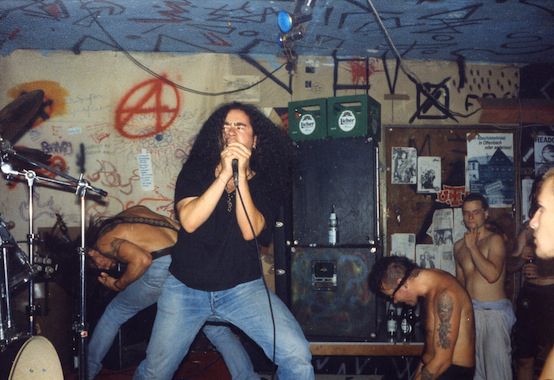White Riot: Punk Rock and the Far Right

It turns out that Wade Michael Page, the alleged murderer of six people at the Sikh temple in Oak Creek, WI, played in white power rock bands. In addition to shedding light on Page’s possible motive, the discovery has stimulated discussion on the connection between hard-and-heavy music and far-right politics.
Some commentators, including Scott Galupo, suggest that it may be no coincidence that Page moved from aesthetic violence to real violence. At Slate, Amanda Marcotte argues that Page’s racist views had nothing to do with the mainstream (if the word can be used in this context) of hardcore punk. At National Review, Robert Verbruggen extends this argument to metal.
As “the academy’s premiere surreptitious punkacademic” (at least according to Wired‘s Spencer Ackerman, with whom I’ve been listening to punk rock for nearly 20 years), I feel a certain responsibility to weigh in here. My basic response is that both sides are right.
On the one hand, racism and extreme-right politics have been marginal features of the punk scene since they emerged in the late 1970s. When they’ve experienced bursts of popularity, as in the Oi! movement, they’ve been resisted by bands and fans, from Rock Against Racism to the Dead Kennedy’s charmingly direct “Nazi Punks F**k Off“. Punk’s pioneers, including the Sex Pistols, had flirted with explicit Nazi imagery. But the fad for swastika armbands was brief. It had been replaced, by the early ’80s at the latest, with a self-consciously left-wing political atmosphere.
On the other hand, the periodic appearance of far-right elements in punk isn’t coincidental. Even when the lyrics urge peace and tolerance, the sound is aural warfare. With some exceptions, most notably the Clash, punk is defined by removal of musical elements coded as “black” (these are also the elements associated with sex). The result is an aesthetic expression of pure rage. If you don’t usually listen to this kind of thing, imagine a drill sergeant chastising recruits inside the engine of a tank.
What happens in the music happens literally at performances. The characteristic dance is a ritualized brawl punctuated by collective chanting. There are rules for moshing, as it’s known: the crowd picks up anyone who falls, and aimed blows are frowned upon. But it’s essentially a melee.
Pacifist, anarchist, and lover of animals may all enjoy this kind of thing. In Foreign Policy, Ackerman investigates the long history of left-wing activism by punk bands, including Russia’s Pussy Riot, who are now facing prosecution for “hooliganism motivated by religious hatred”. Still, it’s not an accident that punk also attracts thugs who like to shout and fight, without much caring where they direct their anger. They are the targets for recruitment by far-right groups who lurk on the margins of the scene.
That’s why the punk scene is forced to engage periodic bouts of self-policing. The tough guys and neo-nazis are the inescapable bad conscience of a movement that’s based on transformations of violence into art and of art into violence, but rejects the political implications and historical associations of this dynamic.
The challenge for punks who understand the paradox is to make music that uses the punk musical vocabulary but is, to paraphrase Walter Benjamin, useless for fascism. That’s been the goal of the best and most interesting punk bands over the last three decades, including Gang of Four, the Minutemen, Rite of Spring, Fugazi, and Bikini Kill. But the lure of racialized violence is part of punk’s genetic code, a kind of cultural original sin. As the Clash sang in 1977, the year of punk’s symbolic founding, “White riot, I wanna riot of my own.”
Comments